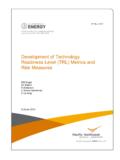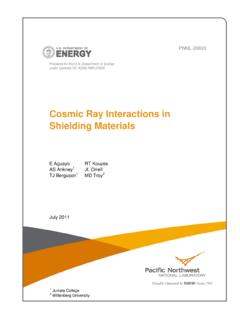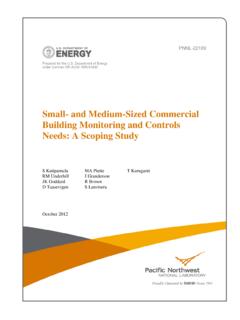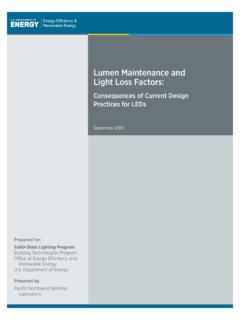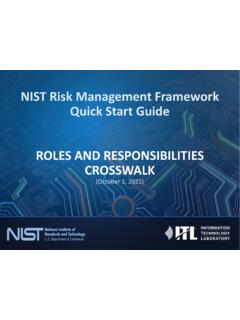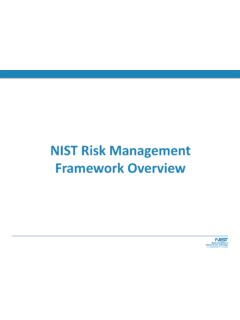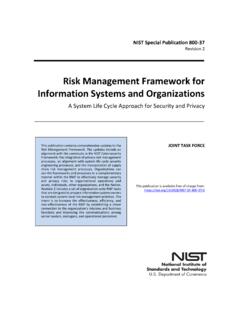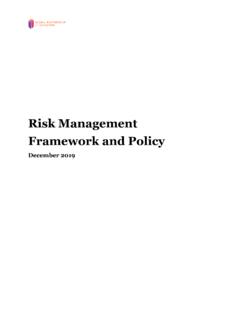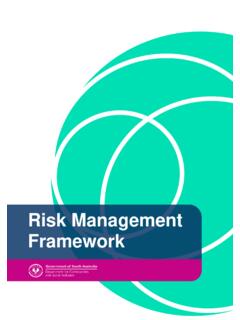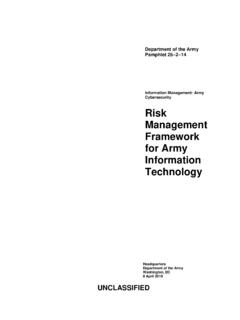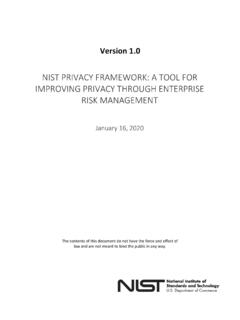Transcription of Risk Management Framework Process Map
1 PNNL-28347 Prepared for the Department of Energy under Contract DE-AC05-76RL01830 Risk Management Framework Process Map Prepared for the Federal Energy Management Program November 2018 ME Mylrea MD Watson SNG Gourisetti JE Castleberry M Touhiduzzaman iii Acronyms and Abbreviations AO Authorizing Official ISO Information System Owner ISSO Information System Security Officer NIST National Institute of Standards & Technology POA&M Plan of Action and Milestones RAR Risk Assessment Report RMF Risk Management Framework SAR Security Assessment Report SCA Security Control Assessor SCTM Security Controls Traceability Matrix SP Special Publication SSP System Security Plan iv Contents Acronyms and Abbreviations .. iii Introduction .. 1 The Risk Management Framework .
2 1 RMF Roles and Responsibilities .. 3 RMF Step 1 Categorize Information System .. 4 RMF Step 2 Select Security Controls .. 4 RMF Step 3 Implement Security Controls .. 5 RMF Step 4 Assess Security Controls .. 6 RMF Step 5 Authorize Information System .. 7 RMF Step 6 Monitor Security 8 References .. 11 Appendix A Updates to the Risk Management Framework .. v Figures 1. RMF for Information and Platform Information Technology Systems .. 1 2. Document Mapping for RMF .. 2 3. Multi-Tiered Risk Management Strategy .. 2 Tables 1. RMF Step 1 Categorize Information System .. 4 2. RMF Step 2 Select Security Controls .. 5 3. RMF Step 3 Implement Security Controls .. 6 4. RMF Step 4 Assess Security Controls .. 6 5. RMF Step 5 Authorize Information System.
3 7 6. RMF Step 6 Monitor Security Controls .. 9 1 Introduction The purpose of this document is to provide an overview of the Risk Management Framework (RMF) codified in National Institute of Standards & Technology (NIST) Special Publication (SP) 800-37r1 for the Federal Energy Management Program (FEMP). This document, while accurate, is not an authoritative source on the Management of federal information systems. However, the concepts and Process discussed herein are representative of the data points used to compare the RMF with NIST s Framework for Improving Critical Infrastructure Cybersecurity, otherwise known as the cybersecurity Framework . The Risk Management Framework The RMF is a six-step Process meant to guide individuals responsible for mission processes, whose success is dependent on information systems, in the development of a cybersecurity program.
4 Among other things, the RMF promotes near-real-time risk Management of information systems; links risk Management processes at the system level with the organization s strategic goals and risk function; and establishes responsibility for security controls for information systems within the organization s defined boundary (NIST 2010). Figure 1 shows the iterative nature of the six-step RMF Process . Figure 1. RMF for Information and Platform Information Technology Systems (NIST, 2010) The RMF is a living, comprehensive Process that requires an appropriate amount of due diligence to be effective. Figure 2 depicts the available NIST authored guidance documents to assist in each step of the RMF Process . 2 Figure 2. Document Mapping for RMF A core concept to the RMF is risk Management .
5 The RMF makes use of NIST SP 800-39, Integrated Enterprise-Wide Risk Management : Organization, Mission, and Information System View. Enterprise risk Management involves a multitiered approach connecting strategic goals with the daily operations of information systems. Figure 3 depicts this structured risk Management Process (NIST 2011b). Figure 3. Multi-Tiered Risk Management Strategy Tier 1 frames the organization risk and informs all other activities. This is where leaders set priorities and create policies to achieve strategic objectives. Tier 1 includes, among other things, governance of the organization to set priorities; the risk executive function to manage organization-wide risks ; determination of the risk Management strategy to provide a common Framework at all levels of the organization; and the investment strategy to achieve mission and risk priorities, anticipate risk response needs, and limit strategic investments to align with organizational priorities.
6 Tier 1 sets the direction for Tier 2 managers. 3 Tier 2 focuses on developing risk-informed mission processes to meet leadership s stated goals. Tier 2 includes the identification and development of risk-aware mission processes to achieve strategic goals; the administration of an enterprise architecture to enable mission processes; and establishment of a consistent information system architecture to cost-effectively ensure resilience of mission-critical information system assets. Tier 2 builds an organizational infrastructure conducive to the successful execution of activities at Tier 3. Tier 3 uses the mission processes developed in Tier 2 and the goals set in Tier 1 to conduct the day-to-day activities that make the organization successful. Tier 3 addresses risk from an information system perspective.
7 These activities are the culmination of the organization s risk Management strategy and ensure that individual systems are secure, reliable, and available to execute mission processes. In October 2018, NIST announced the final draft of NIST SP 800-37, revision 2 that modifies the RMF Process . The modification is discussed in Appendix A; however, because most organizations will be slow to transition to version 2, this paper focuses on the initial version of the RMF. RMF Roles and Responsibilities The RMF identifies 13 roles and responsibilities of key participants in the organization s risk Management . It is not necessary for each role to exist within the organization, but the duties performed must be accomplished diligently and be assigned to individuals or groups that do not have conflicting interests.
8 Risk Management roles and responsibilities include the following: Chief Executive Officer Responsible for the organization s success. Risk Executive Responsible for the organization s risk program. Chief Information Officer Responsible for designating a senior information security officer; developing and maintain information security policies, procedures, and control techniques; overseeing personnel; and assisting senior leaders on all security responsibilities. Information Owner Responsible for statutory, Management , or operational authority and the establishment of policies and procedures governing its generation, collection, processing, dissemination, and disposal. Senior Information Security Officer Responsible for carrying out the chief information officer security responsibilities and serving as the primary interface between senior managers and information system owners.
9 Authorizing Official (AO) or Designated Representative Responsible for accepting an information system into an operational environment at a known risk level. Common Control Provider Responsible for developing, implementing, assessing, and monitoring common security controls. Information System Owner (ISO) Responsible for procuring, developing, integrating, modifying, operating, and maintaining an information system. Information System Security Officer (ISSO) Responsible for ensuring that the appropriate operational security posture is maintained for an information system. 4 Information Security Architect Responsible for ensuring that the information security requirements necessary to protect the organization s core missions and business processes are adequately addressed in all aspects of enterprise architecture.
10 Information System Security Manager (ISSM) Responsible for conducting information system security Management activities as designated by the ISSO. They develop and maintain the system-level cybersecurity program. Security Control Assessor (SCA) Responsible for conducting a thorough assessment of the Management , operational, and technical security controls of an information system. RMF Step 1 Categorize Information System To categorize an information system, first categorize the information on the system, according to the potential impact of a loss of confidentiality, integrity, and availability. Table 1 lists the subtasks under Step 1, shows who is responsible, and describes each subtask s deliverable. Table 1. RMF Step 1 Categorize Information System Supporting Tasks Primary Responsibility References Deliverable(s) Task 1-1 Categorize the information system and document the results in the System Security Plan (SSP).

